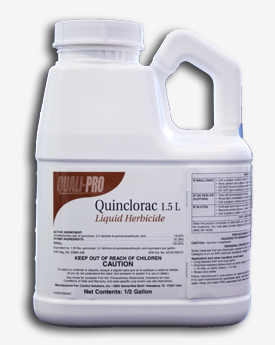Active chemicals play a crucial role in herbicide products. To pick the right herbicide, one should know all the pros and cons of these active chemicals. These active ingredients provide a rapid-action control to yearly and permanent weeds, and they have some negative effects as well. Quinclorac is one of the best active chemicals in many herbicide products, and it’s preferable because of its special features. So, to know the relevant details of the Quinclorac, you’re suggested to go through this whole article.
What is Quinclorac?
Quinclorac is an active ingredient of many herbicide products, including Drive XLR8, Quinclorac 75 DF, and others. This rapid-action chemical is famous due to its eradication ability and unique features. It can terminate many nasty weeds such as crabgrass, wild bergamot, foxtail, sedge grass, clover, dandelion, broadleaf weed, barnyard grass, etc. The mechanism of this chemical is simply great as it reduces unwanted weeds without even damaging the useful weeds. Once you have sprayed the chemical, then it will instantly be absorbed by the roots of the toughening weeds and also by the germinating seeds. This action will lead to the instant growth of a plant, then eventually, the death of the plant will occur. The effectiveness of this chemical depends upon multiple factors that incorporate temperature, moisture content, soil type, and organic matter. The transmission of quinclorac increases with the increase in temperature and moisture content of the soil. The implications of this chemical are in rural areas, industrial sites, golf sites, sports fields, grazing lands, and some urban areas as well.
Quinclorac label
Before using any product, it is necessary to read the label on that product first. The label on this product includes some precautionary statements as follows.
● Avoid the contact of quinclorac herbicide with your eyes, skin, and clothes. If accidentally you’ve contacted this chemical, then wash that particular area with soap and water to remove its effect.
● Keep this herbicide out of the reach of children and do not treat those areas with this product that are easily accessible to children and pets.
● Wait for at least a few hours for the product to dry, then you can allow the pets and children to access that area.
● To get the optimal result, use quinclorac herbicide with methylated seed oil according to the required proportions.
Quinclorac toxicity
The active chemical Quinclorac is less toxic as compared to other toxic chemicals. The herbicides in which quinclorac is present, when not applied as per instructions then they can cause slight damage to organs during inhalation. Also, minimal irritation in the eyes and skin can take place if the chemical comes in contact. Besides these indications, there is no such hazardous effect of this chemical on human health.
Quinclorac safety
While using any herbicide, it’s mandatory to first read the safety precautions on its label. The necessary safety measures for quinclorac are listed below.
● Try to use the quinclorac herbicide in an open-air and avoid breathing while applying.
● Always wear gloves, masks, and safety goggles, before mixing the quinclorac herbicide with water.
● Immediately wash your hands with sanitizer or soap after the implementation of quinclorac herbicide.
● Rinse the equipment with water thoroughly when you’ve completed your job.
● If mistakenly the product comes in contact with the skin or eye, then immediately wash your skin or eye with water. You can also consult with the doctor.
Quinclorac instructions
To get the instant eradication of toughening weeds, one should follow the proper instructions mentioned on the product label. The instruction for the quinclorac herbicide is mentioned below.
● First, you need to choose the type of sprayer. If you’re using a pump sprayer, then you have to add half of the water to the sprayer.
● Second, you need to add the optimal amount of quinclorac herbicide mentioned on the label with any liquid fertilizer to the sprayer tank and mix it well.
● Now, add the remaining amount of water to the sprayer tank and mix it again.
● A maximum of 2 lbs (pounds) can be applied per acre per year for the optimal results.
Quinclorac vs Tenacity
Quinclorac 75 DF controls toughening weeds, and it’s a post-emergent weed controller, while Tenacity herbicide is a combination of both pre and post-emergent weed controllers. The active chemical for Quinclorac 75 DF is quinclorac, and for Tenacity, the active chemical is mesotrione. Both the herbicides eradicate broadleaf weeds and other nasty weeds effectively. Chickweed, Clover, Crabgrass, Dandelion, Foxtail, Henbit, Nutsedge, wild bergamot, foxtail, and sedge grass are some of the weeds that are efficiently controlled by these herbicides. Quinclorac herbicide is less toxic as compared to Tenacity herbicide.



